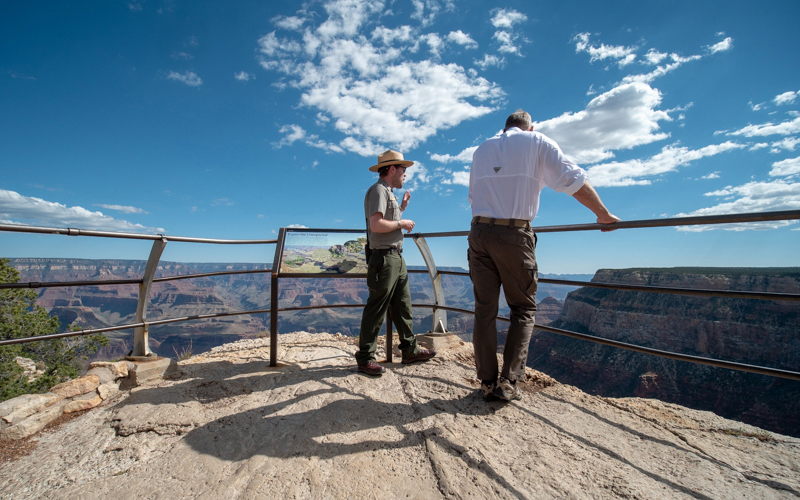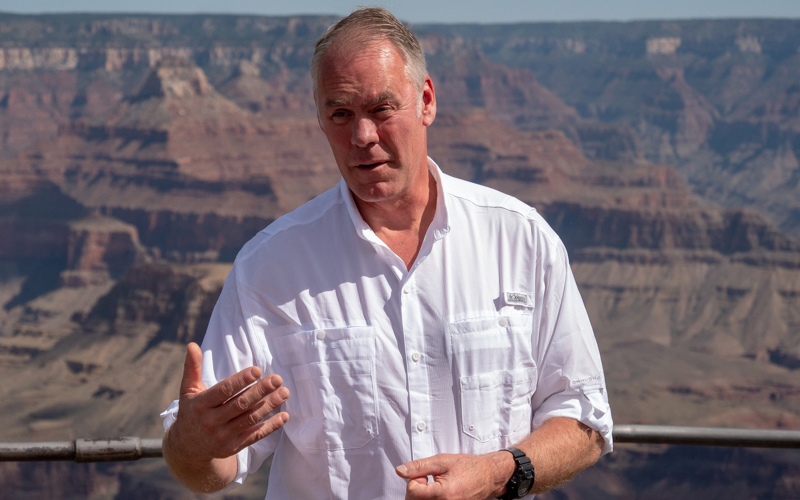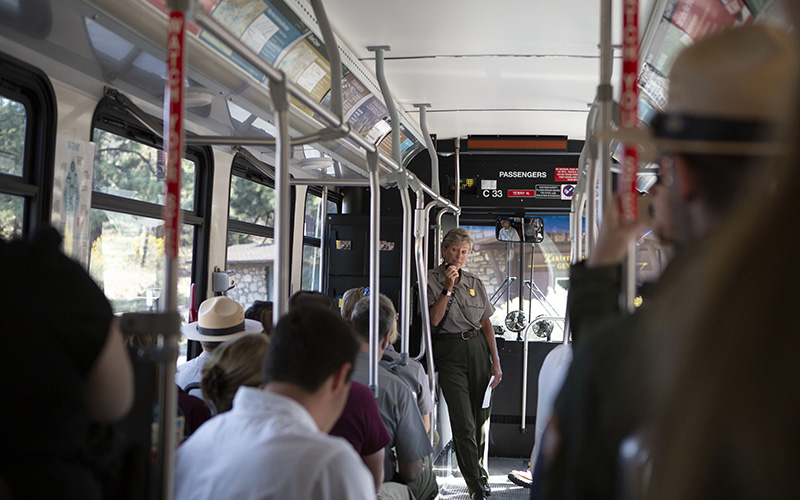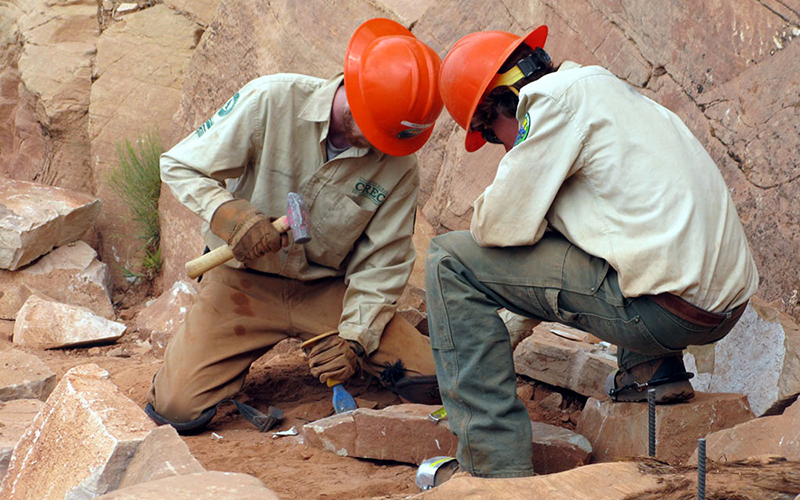
National Park Service geologist Mitch Sawicki (left) and Interior Secretary Ryan Zinke visit Hopi Point. Zinke was at the South Rim to talk about the Restore Our Parks and Public Lands Act, which would fund a backlog of repairs at national parks. (Photo by Jordan Evans/Cronkite News)

Against the backdrop of the Grand Canyon, U.S. Interior Secretary Ryan Zinke discusses ways to fund an estimated $12 billion in repairs for national parks. Zinke spoke on National Public Lands Day. The park admitted visitors for free to celebrate the day. (Photo by Jordan Evans/Cronkite News)
GRAND CANYON VILLAGE – The Grand Canyon twists through northern Arizona, a deep gash cut by the Colorado River. But the river had help from wind, rain and scorching sun, which also has battered its lodges, roads, and utility structures.
On Saturday, Secretary of the Interior Ryan Zinke visited Grand Canyon’s windswept roadways, sunbaked cabins and aging wastewater treatment facility to bring attention to the National Park Service’s $11.6 billion backlog in maintenance projects. These are “deferred maintenance” projects, from roads to buildings, that have had work postponed because of budget constraints.
Zinke joined volunteers painting six cabins built in the 1930s and talked about congressional legislation he thinks would give the agency the funds to fix infrastructure.
There are at least three bills in Congress to provide billions of dollars for park repairs: The National Park Legacy Act and the National Park Restoration Act in the Senate; and the Restore Our Parks and Public Lands Act, which cleared the House Natural Resource Committee earlier this month on a voice vote. Zinke supports that House bill.
The committee’s chairman, Rep. Rob Bishop, R-Utah, worked with Rep. Raul Grijalva, D- Ariz., the committee’s ranking leader, to get the legislation out of committee. At Zion National Park on Sunday, Zinke told the Deseret News “that’s a milestone,” that Bishop and Grijalva could agree on the bill.
“Parks are not a Republican or Democrat issue,” Zinke said Saturday. “Parks are an American issue.”
Both Restore Our Parks and the National Park Restoration Act would establish funds that would take some revenue from energy development – oil and gas, solar and wind – on federal lands to pay for park repairs.
National parks in Arizona have almost $530 million in deferred maintenance, nearly $330 million of which is at Grand Canyon National Park.
“It’s time for America to step up and rebuild our parks to make sure we have the same experience for the next generation,” Zinke said. With more than 330 million National Park visitors a year – more than 6 million of them at Grand Canyon – the country’s parks “are being loved to death,” he added.

Chris Lehnertz, superintendent of Grand Canyon National Park, leads a bus tour of the South Rim that included U.S. Interior Secretary Ryan Zinke, park officials and members of the news media. The National Park Service has a nearly $12 billion backlog in maintenance projects that need repairs – including almost $330,000 at the Grand Canyon. (Photo by Corey Hawk/Cronkite News)
But performing any work in Grand Canyon is challenging because of the extreme landscape. For instance, said Chris Lehnertz, Grand Canyon National Park’s superintendent, helicopters have to pick up barrels of compost from park toilets and fly them to treatment plants.
Potable water also is a major issue. All drinking water for the South Rim is pumped from a spring on the North Rim, she said.
“That system, which is called the Trans-Canyon Water Line, is out of date and it’s failing. It’s over 50 years old,” said Lehnertz, adding that updating the water line is the park’s biggest project
As for congressional action to address the problem, the superintendent said the National Park Service doesn’t support any given piece of legislation, but “we do take a position on how important it is to get this work done.”
Volunteers are one way to get some of the work done, like on Saturday when Zinke helped paint the old cabins.
Brytnee Miller, representing the Center for Biological Diversity, an environmental group in Tucson, acknowledged Zinke’s effort to improve the six cabins, but she was concerned about his track record of opening federal lands for private development. She led a five-person protest against Zinke and his policies Saturday.
She said her organization takes particular effort to defend national parks, which are home to many animals.
“These are ancient corridors for wildlife migration,” Miller said. “This is sacred land with cultural significance. It’s where people enjoy being outdoors. We work to protect those things.”
Miller doesn’t support drilling for oil on federal land, which the Restore Our Parks and Public Land Act includes.
“He (Zinke) would have to really step his game up and show … it’s not just dirty energy that’s fueling this restoration fund, because what is restoration if it’s coming from more destruction?” Miller said, referring to coal and oil.
Zinke said the Restore Our Parks Act would draw on all forms of energy including wind, solar and oil.
“I think it’s shameful, some of these outlandish accusations,” Zinke said about criticisms of the Restoration Act. “No one loves public land more than me.”
– Video by Jordan Evans
This story is part of Elemental: Covering Sustainability, a new multimedia collaboration between Cronkite News, Arizona PBS, KJZZ, KPCC, Rocky Mountain PBS and PBS SoCal.
Subscribe to Cronkite News on YouTube.

